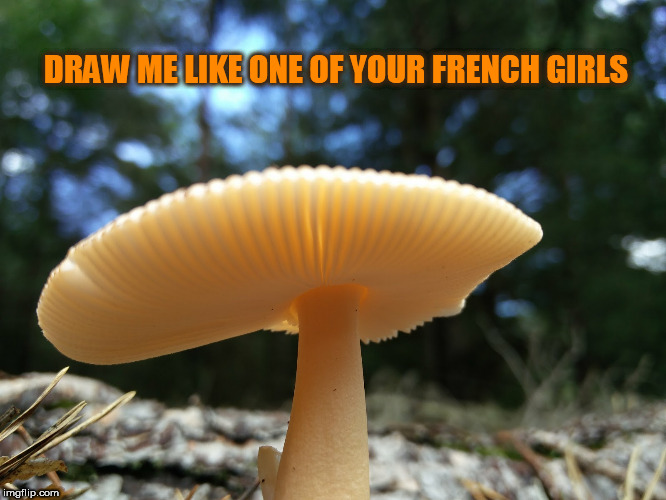Ambersham Common is one of the important heathland sites in the South Downs National Park. As well as great expanses of heather, which were putting on an impressive show this weekend, it also includes areas of birch woodland and conifer plantation.
After the recent rain, mushrooms were popping up all over the place – looking fabulous.
I think this one, with its tan-coloured cap, stripy edge to the cap ('striate margin') and bag-like volva at the base of the stipe, is Tawny Grisette Amanita fulva.
This photo shows cap colour and striate margin quite nicely.
It really is an elegant looking thing...
... quite coquettish. So much so, I think it deserves to enter the canon of "draw me like one of your french girls" memes. Those gills! That stipe!
Apparently (according to wikipedia), the word "grisette" was commonly used in the 19th century to refer to a French working-class woman and in 1835 was defined in one of the French dictionaries as:
"a young working woman who is coquettish and flirtatious."
So the meme is more apt than I'd realised. Ha!
In an area of birch and conifer woodland nearby I spotted the crusty cap of another Amanita.
Here it is up close.
It had a pendulous and striate ring around the stipe.
I have convinced myself the flesh turned slightly pink when damaged. It also didn't smell of radishes (a feature of the similar-looking Grey-spotted Amanita A. excelsa var. spissa). I think this makes my mushroom The Blusher Amanita rubescens.
That particular mushroom was growing singly but, along one of the rides at the edge of the Common, we also came across this group growing together. I think these were also The Blusher Amanita rubescens.
Down the slope, in another area of conifer woodland, I was delighted to come across this bright pink slime mould, growing on a rotting conifer log.
It was very helpfully showing off both its amorphous pink plasmodial form (shiny blob at the top), and its pink 'pseudoaethalium' – the densely clustered group of spore-producing structures called sporangia.
In this photo you can see the sporangia are shaped like lots of tiny sausages, sitting on top of a layer of white gunk called the hypothallus.
Looking downwards on the fruit body (as in the top photograph) you just see the tips of the sausage-shaped sporangia, looking a bit like a raspberry.
All these features are a good match for Red Raspberry Slime Tubifera ferruginosa. Bruce Ing, in his book The Myxomycetes of Britain and Ireland, notes "there are no other species to confuse with this in the British Isles; it can be identified as soon as it emerges from the wood." So I think I can be reasonably confident in this identification.
Growing on another rotting conifer log, I found these pale yellow blobs. They looked too misshapen to be Small Stagshorn Calocera cornea, which I've seen in a few places recently.
Looks like it might be Pale Stagshorn Calocera pallidospathulata, which the Collins (photographic) Guide says grows on the decayed wood of conifers.
Another interesting find for me was this bracket fungus growing on birch stumps.
When my friend Laurie pointed this out to me, I just caught a glimpse of some fairly flat semi-circular brackets with concentric rings of colour and gave her my stock response for moments such as these: "I think it's Turkeytail."
But something made me take a closer look, and what I found on the underside took me completely by surprise.
Gills! It seems Laurie had found Birch Mazegill Lenzites betulinus. Another new species for me.
For the record
Date: 30/07/2017
Location: Ambersham Common and surrounding woodland
Grid reference: SU9119
Records entered into FRDBI 06/09/2018















The climatic conditions produced a similar suite of fungi at Bedgebury where we found Tawney Grisette and, as you did, many blushers. However under the trees there were lots of Russulas including R. violeipes, R.betularum and R.cynoxantha.
ReplyDeleteThat's interesting. I must confess I did find one Russula on Sunday, over the road on Heyshott Common. A yellow one. I've rather got in the habit of ignoring Russulas - too difficult! But there is really no excuse for this behaviour now I've got Geoffrey Kibby's excellent book...
Delete